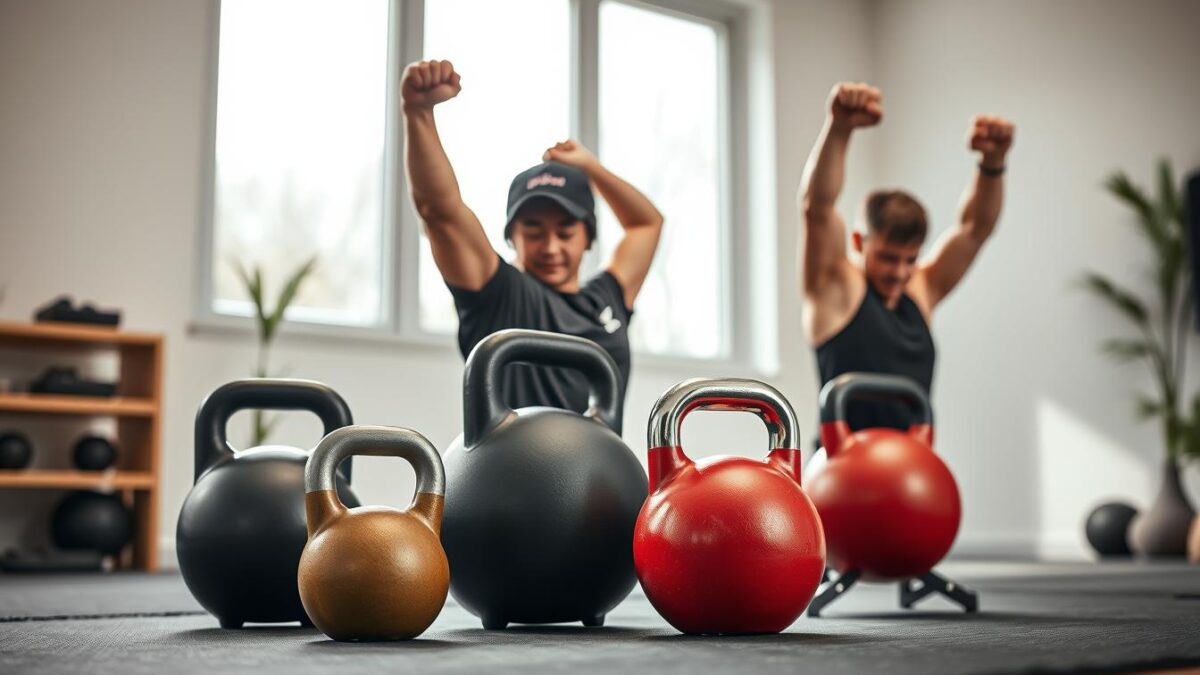
4 Kettlebell Swing Variations & When to Use Them
Looking to add some excitement to your kettlebell workouts? Try out different kettlebell swing variations. These changes not only work different muscles but also boost your strength and endurance. Whether you’re new to kettlebells or have some experience, learning these techniques can make your workouts more varied and effective.
Introduction to Kettlebell Swings
Kettlebell swings are key in functional fitness, working out many muscles at once. They boost strength and heart health, making them popular among those who love to stay fit. If you’re new, don’t worry; learning the basics is easy and fast.
Knowing how to hinge, press, and squat with kettlebells is important. Start with a weight you can handle to focus on your form. This is key to avoiding injuries. The kettlebell’s shape helps you move in ways that build strength and balance.
Understanding the Benefits of Kettlebell Swings
Kettlebell swings are a game-changer for your workouts. They help build core strength, improve balance, and boost flexibility. These exercises target key muscles like the hamstrings, glutes, and lower back.
When done right, kettlebell swings can get your heart rate up like running. This makes them a great combo of strength training and cardio. You get more out of your workout time.
Kettlebell swings also improve explosive power and coordination. Athletes love this because it helps in sports. Plus, they help you feel more connected to your body, which is key in fitness.
Key Technique Tips for Effective Kettlebell Swings
Starting with the right kettlebell form is key. Stand with your feet shoulder-width apart. Keep your back straight and your core tight. This helps you get the most out of your swings and keeps you safe.
Lower the kettlebell between your legs by hinging at your hips. Always keep your spine neutral to protect your back. The power comes from your hips and glutes, not your arms.
Keep a slight bend in your elbows as you swing. Snap your hips forward to lift the kettlebell. This hip action makes the swing smooth and powerful. Mastering these techniques will improve your workouts.
Russian Kettlebell Swing: The Classic Move
The Russian kettlebell swing is a key exercise for starting with kettlebells. It works the back and improves core strength. Here’s how to do it right and when to add it to your routine.
How to Perform the Russian Kettlebell Swing
To do the Russian kettlebell swing correctly, follow these steps:
- Stand with your feet shoulder-width apart, holding the kettlebell with both hands in front of you.
- Hinge at your hips, pushing them back while letting the kettlebell swing between your legs.
- Drive your hips forward explosively, allowing the kettlebell to swing up to eye level.
- Maintain a straight back and keep your elbows slightly bent throughout the movement.
This way, you work your core and lower body well while keeping the right form.
When to Use the Russian Kettlebell Swing
The Russian kettlebell swing is great for beginners to improve their technique. Even experienced athletes can use it to boost power and endurance. Add the Russian kettlebell swing to:
- Strength training sessions focusing on core and posterior chain development.
- Metabolic conditioning workouts for a quick and efficient energy boost.
- Lower body strength routines to ensure proper form and control.
This move fits many workout styles and helps you get the most out of your training.
American Kettlebell Swing: The Advanced Variation
The American kettlebell swing is a step up from the traditional swing. It involves swinging the kettlebell all the way overhead. This move not only tests your muscles but also boosts your fitness level.
When you hold the kettlebell with both hands, you start a powerful swing. This swing lifts the kettlebell above your head. It works your shoulders, back, and core harder than the Russian swing.
Benefits of the American Kettlebell Swing
This swing has many benefits. It strengthens your muscles through a bigger range of motion. This makes your body work harder, improving your power and stability.
It also helps your athletic performance. The American kettlebell swing increases your heart rate, improving your cardiovascular fitness.
Before trying this variation, it’s important to master the Russian kettlebell swing. Knowing the basic swing well helps keep your form right. This reduces injury risks and maximizes the benefits of this intense move.

Alternating Kettlebell Swing: Enhance Coordination
The alternating kettlebell swing makes your workouts more challenging. It focuses on hand coordination and builds strength. You switch hands at the swing’s peak, boosting focus and control.
Use this exercise to boost coordination with kettlebells. It keeps your training interesting and effective.
Steps to Master the Alternating Kettlebell Swing
- Start with a standard two-handed kettlebell swing to establish a solid foundation.
- Grip the kettlebell with your right hand, swinging it back between your legs.
- As the kettlebell comes forward, propel it up to shoulder height.
- At the top of the swing, release the kettlebell and catch it with your left hand on its descent.
- Repeat the movement, now switching back to your right hand, ensuring smooth transitions.
Ideal Scenarios for Alternating Swings
Use alternating kettlebell swings in circuit training or functional workouts. It targets both sides of the body, engaging your core and shoulders. It’s great for athletes and fitness lovers looking to improve coordination with kettlebells.
Adding this exercise can make your training sessions more exciting. It offers a new challenge that keeps you motivated.
Kettlebell Swing Variations for Targeted Muscles
Kettlebell variations let you tailor your workouts to target specific muscles. Changing your grip or stance can engage different body parts. This makes your fitness routine more effective and enjoyable.
Using one arm for kettlebell swings works your shoulders hard. It builds strength and stability. Lateral swings, on the other hand, focus on your obliques. This boosts your core strength and balance.
The squat swing targets your quads and glutes. It’s great for building muscle and improving everyday strength. This variation is perfect for those who want to get stronger for daily activities.
Here’s a summary of the key kettlebell variations and the muscles they target:
| Kettlebell Variation | Targeted Muscles |
|---|---|
| Single Arm Swing | Shoulders, Core |
| Lateral Swing | Obliques, Core |
| Squat Swing | Quads, Glutes |
Adding these muscle-targeting kettlebell swings to your routine can make your workouts more varied. It also boosts your strength training. Focusing on specific muscles can lead to better results and a more fun workout.
Incorporating Kettlebell Swings into Your Workout Routine
Kettlebell swings can boost your workout, making them a great fit for many fitness plans. They help improve strength, endurance, and weight loss. You can add them to strength training, HIIT, or cardio routines.
For effective kettlebell workout ideas, mix swings with exercises like push-ups or squats. This creates a circuit that raises your heart rate and works your whole body. Try a ladder workout, increasing reps in each set for better results.
Starting with kettlebell swings can be a great warm-up. Or, add them at the end for extra conditioning. Kettlebell swings add variety to any workout, no matter your level.
Workout Ideas Featuring Kettlebell Swings
- Strength Circuit: Combine kettlebell swings, push-ups, and lunges for a balanced workout.
- HIIT Session: Use kettlebell swings in intervals, alternating with high knees or burpees.
- Cardio Routine: Pair kettlebell swings with jump rope or running for increased cardiovascular impact.
- Ladder Workout: Start with 5 swings, increase by 5 each round until you reach your maximum capacity.
Discover more kettlebell workout ideas to energize your fitness journey at this helpful resource. Kettlebell swings fit seamlessly into any workout plan, leading to better performance and results.
Safety Tips for Kettlebell Swing Exercises
Keeping safe while using kettlebells is key to good training. Start with the right form to avoid injuries. Focus on the hip hinge and keep your spine straight.
Begin with a lighter kettlebell to learn the swing safely. This helps you build confidence and get better before moving to heavier weights. Wrong handling can cause accidents and stop your fitness goals.
Make sure your workout space is free from tripping hazards. This simple step can help prevent accidents during kettlebell swings. If you’re not sure about your form, ask a qualified trainer for help.
By following these safety tips, you can improve your kettlebell workouts and reduce injury risks. These practices help you focus on getting the best results from your exercises.
Wrapping Up Your Kettlebell Swing Training
Adding kettlebell swing variations to your routine is key. Consistency is vital for boosting strength and perfecting your technique. Every swing, whether it’s Russian, American, or alternating, strengthens your muscles and boosts your confidence.
Focus on form over how many swings you do. Adjust as needed and pay close attention to each swing’s details. This way, you’ll get the most out of your workouts and stay safe. Celebrate every small win along the way. They all count in your fitness journey.
Lastly, try out different kettlebell swing styles to keep things exciting. Remember, each workout brings you closer to your fitness goals. You’re on the right track!



